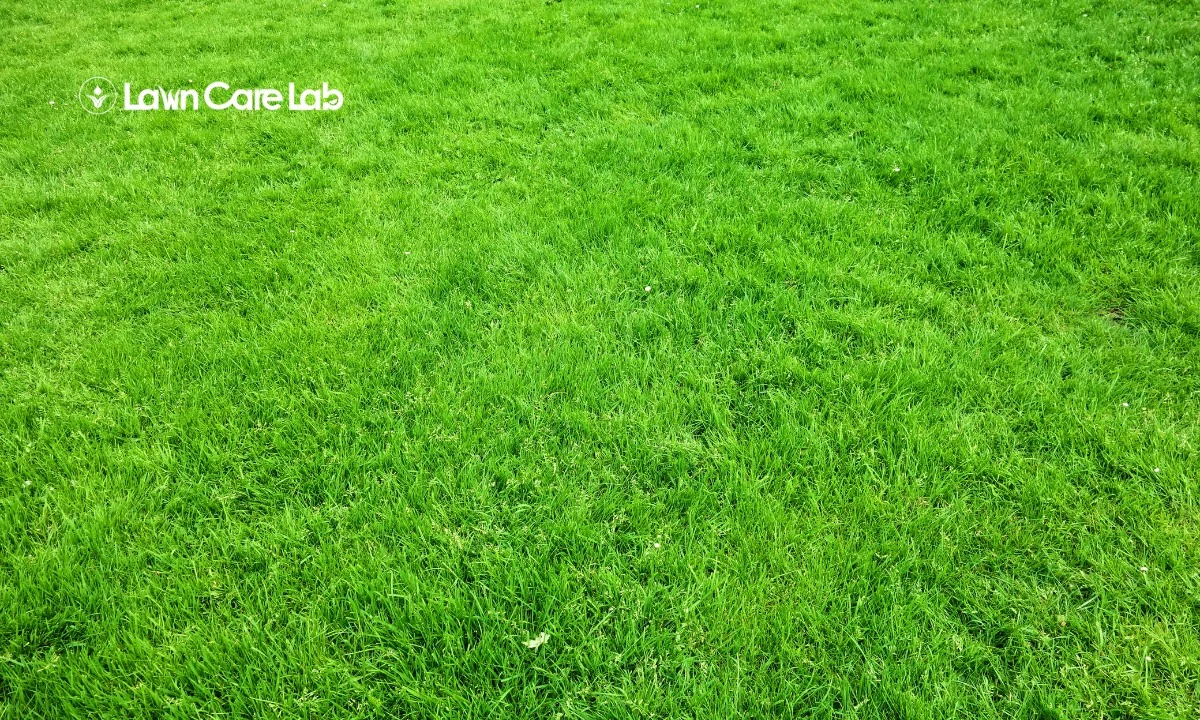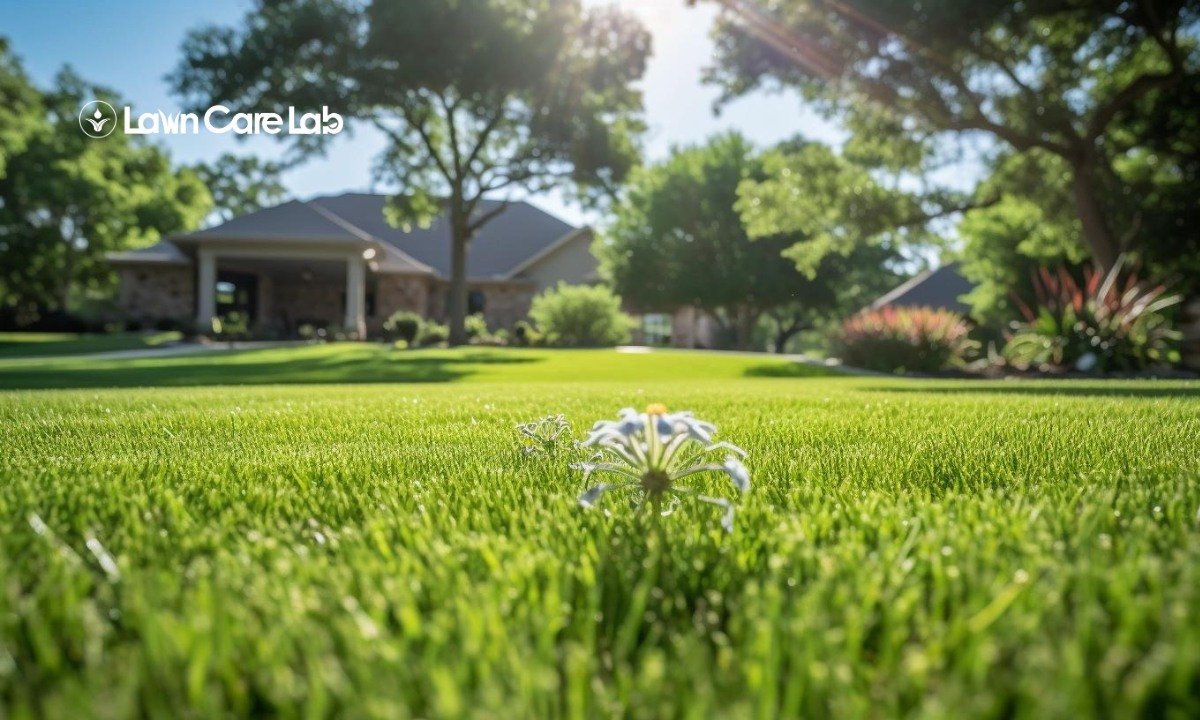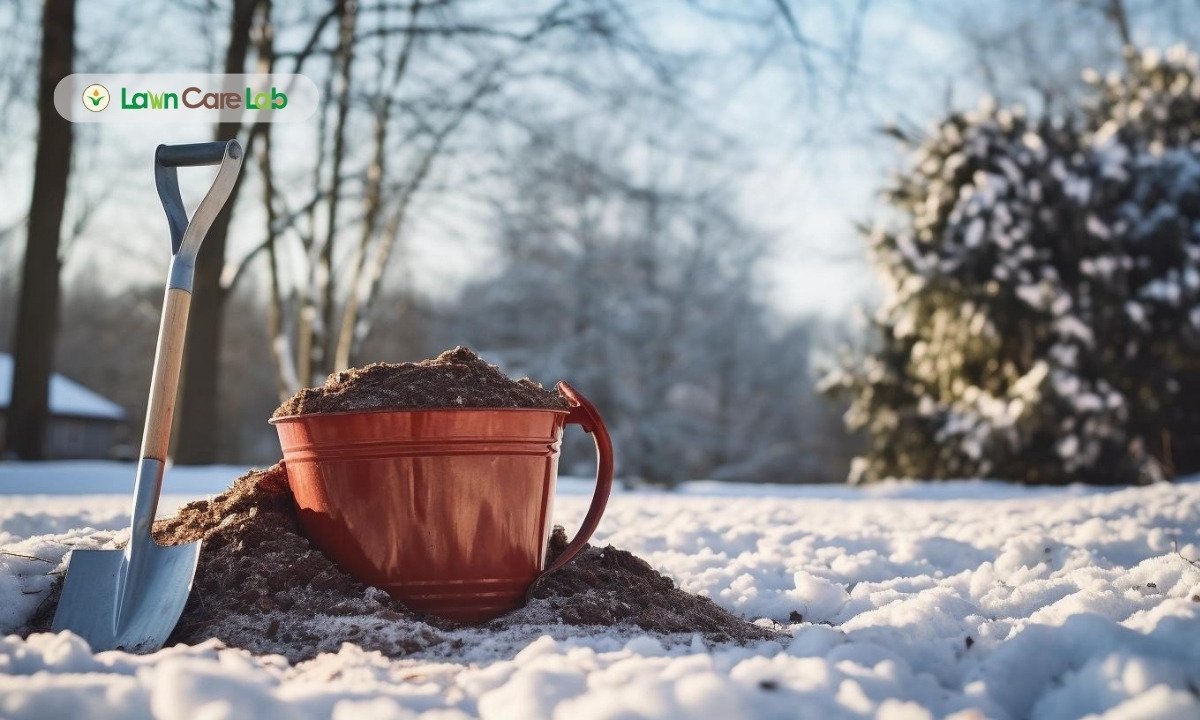Congratulations, you’re in the right place! No more fighting the intense Central Valley heat on your own. We’re here to guide you in transforming your barren yard into a lush oasis lawn in California’s hot Central Valley.
We will teach you everything, from selecting the perfect turfgrass to smart watering techniques, to help you grow a lawn that will have your neighbors green with envy.
Together, we’ll conquer California’s toughest summers and make your lawn flourish.
Ready to revamp your yard? Let’s get started!
Table of Contents
Pick Turfgrass Varieties That Can Handle Valley Summers
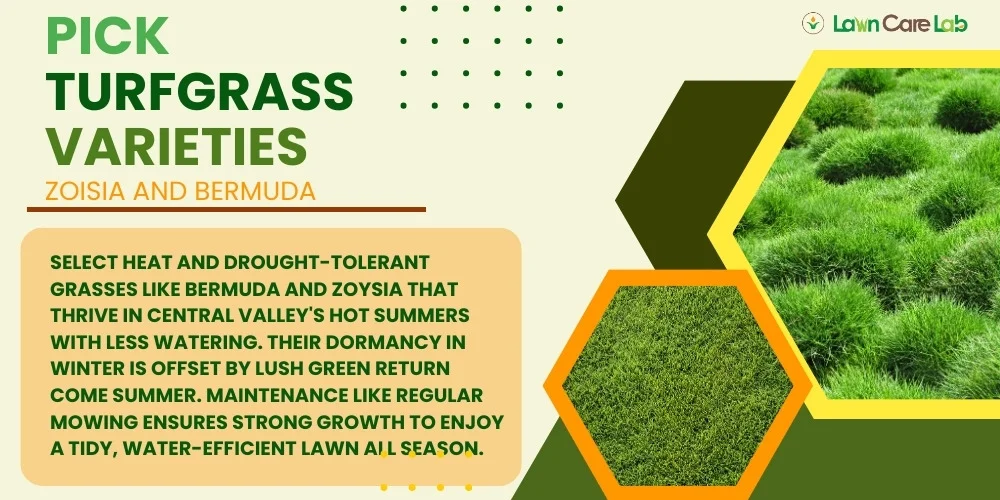
If you’re looking for a lawn that thrives in Central Valley’s hot summers, Bermuda and Zoysia are great options.
They’re heat-resistant and require less water, making them perfect for the region.
Even though they go dormant in winter, you can trust they’ll return to their lush green state when summer comes around.
Bermuda and Zoysia Offer Heat-Tolerance and Low Water Needs
Bermuda and Zoysia grass are great choices for drought-prone areas. They can withstand heat and require less water to stay green, making them ideal for the sweltering Central Valley summers.
Looking to start a new lawn from scratch? Remember that these grasses are a perfect fit for the region’s climate. Plus, they’re pretty easy on the pocket and eco-friendly, as they require less watering.
Regular mowing is the key to a tidy lawn and promotes vigorous growth. Do it right, and you’ll have a lush, sturdy lawn to enjoy the whole summer.
Prepare Soils for Optimal Growth Year-Round
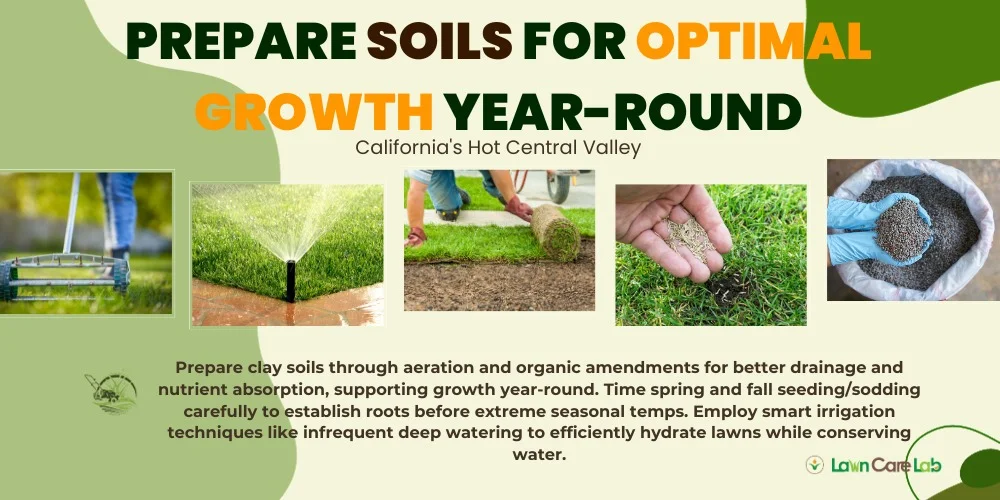
If you want a lush lawn throughout the year, your soil needs some TLC.
Begin with aeration to break up the tight clay soil, followed by adding organic material to enhance the nutrients and moisture-holding capacity.
Make sure to level your lawn for even watering and drainage.
Aerate and Amend Clay Soils
Want a thriving lawn? The secret lies in the soil. Start by aerating your dense clay soils to enhance drainage and nutrient content, paving the way for robust root growth throughout the year.
Here’s a simple guide to amend your soil effectively:
First, aerate your lawn. This step involves using a lawn aerator to create holes and loosen the hardened soil.
Then, sprinkle compost over the aerated area. This organic substance works wonders in improving the soil structure, allowing for easier root penetration.
Last but not least, don’t forget to water your lawn consistently. This helps the compost blend with your clay soil, aiding nutrient absorption and boosting overall soil health.
Level for Even Irrigation and Drainage
Once you’ve improved your clay soils, leveling your ground for proper irrigation and enhanced drainage is crucial. Here’s where smart grading techniques come in handy.
They prevent water accumulation and dry areas and boost the efficiency of your watering methods with well-graded soil.
Plus, don’t forget the importance of adequate drainage systems in soil prep. They keep water from pooling, saving your lawn’s roots from decay.
Time Seeding and Sodding Carefully
It’s crucial to get the timing right when you’re planning to seed or sod your lawn.
For instance, spring is the perfect time to plant cool-season grasses, while warm-season varieties flourish best when planted in fall.
This approach allows the roots to be firmly established before extreme summer or winter temperatures kick in.
Spring and Fall Planting Avoid Harsh Summers and Winters
You might feel like planting whenever, but timing is key. Try to focus on spring or fall planting to dodge Central Valley’s tough summers and winters.
This approach has several advantages. Firstly, overseeding lawns in these seasons can lead to a lush, disease-resistant lawn that keeps weeds at bay.
Secondly, it ensures effective lawn care, minimizing the need for heavy watering and sticking to lawn irrigation best practices.
Lastly, it helps create a lawn that can withstand drought, ideal for the Central Valley’s weather conditions.
Use Water-Wise Irrigation Methods
If you aim for a verdant lawn in California’s warm Central Valley, embracing water-efficient irrigation techniques is essential. Think about utilizing smart controllers; they adapt to the weather and ensure just the right amount of watering, simultaneously saving water.
Smart Controllers and Infrequent Deep Watering
To create a thriving green lawn, you can utilize smart irrigation controllers and engage in occasional deep watering.
These smart devices are fantastic, they can adjust water output based on the weather and type of plant, ensuring an efficient and eco-friendly watering schedule.
Deep watering may not be frequent, but it effectively promotes deep root growth, enabling your lawn to withstand dry spells.
In this way, smart controllers assist in water conservation, making them an essential tool in sustainable lawn maintenance.
Fertilize Sparingly But Strategically
No need to overwhelm your yard with heaps of fertilizer for that vibrant green hue. Just a careful application at the onset of spring, followed by another in summer, works wonders.
This method not only promotes optimal growth but also aids in the recovery of your turf after any potential harm during the warm season.
Early Spring and Summer Feeding Maximize Growth
Start your lawn care routine in early spring by judiciously feeding your grass. Remember, a little fertilizer goes a long way in promoting robust turfgrass growth and curbing weed, pest, and fungus threats. The key lies in preparing the soil well and employing smart watering techniques.
Here’s a simple strategy to follow:
- Start fertilizing when spring kicks in, ensuring your soil is primed and set for nourishment.
- During summer, lightly feed your lawn to cover sparse patches while being conscious of water consumption.
- Keep a constant watch for any weed, pest, or fungus trouble, and act immediately if you spot any.
Mow Warm Season Grasses Low and Cool Season High
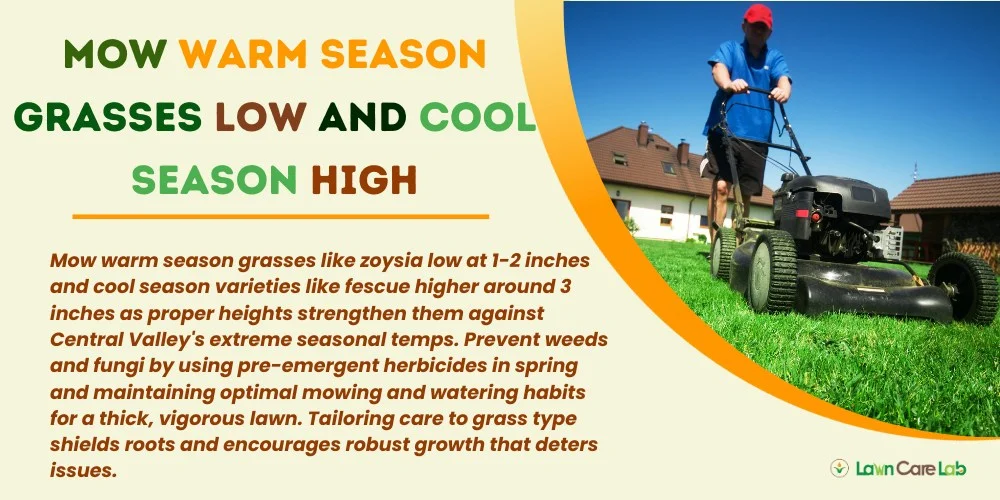
Maintaining a healthy lawn requires some strategy in the scorching Central Valley of California.
Warm-season grasses like Bermuda and zoysia should be kept between 1 to 2 inches high, while cool-season varieties such as tall fescue flourish at around 3 inches. This isn’t just for looks but a critical part of lawn care to promote grass vitality.
Mowing warm season grasses low encourages thick growth, capable of enduring extreme heat. In contrast, cool-season grasses need a bit more length to shield their roots from strong sunlight.
Prevent Weeds, Pests and Fungus
Keeping your lawn in top shape involves dealing with weeds, bugs, and fungi.
A good first step is using pre-emergent herbicides to nip weed growth in the bud.
Balancing the height and hydration of your grass can also keep fungi at bay.
Don’t forget to act swiftly with pest control measures to avoid any harm.
Pre-emergent herbicides and Proper Mowing
Maintaining a lush lawn in the Central Valley of California might seem daunting, but it’s achievable with the right methods. Using pre-emergent herbicides, you can stop weed problems before they start by interrupting the germination process.
However, it’s not all about chemicals – your mowing habits are equally crucial. To keep your lawn healthy and weed-free, implement these three steps:
First, apply pre-emergent herbicides in early spring to nip weed growth in the bud.
Second, keep your grass around 2-3 inches high to create a thick turf that deters weed invasion.
Lastly, ensure regular mowing, but limit cuts to no more than a third of the grass blade to prevent lawn stress.
Conclusion
You might believe transforming your desolate California land into a green haven is a fantasy, but it’s not! Opt for the right grass, prime your soil, and water smartly, and you’ll have a thriving lawn, even amid the Central Valley’s blistering summers.
Proper mowing, strategic fertilizing, and weed control are all it takes. Just like that, you’ve conquered the seemingly insurmountable challenge.
Bid farewell to the barren landscape and welcome your personal paradise. Lawn maintenance can be surprisingly exciting, isn’t it?
Frequently Asked Questions
What Specific Types of Grass Are Best for Shady Areas in California’s Central Valley?
For shady spots in California’s Central Valley, go for St. Augustine or Tall Fescue grasses, as they require less sunlight. Remember to use the right seeding methods, prepare the soil, and keep it hydrated with mulch for successful growth.
How Do I Protect My Lawn From Pet Damage?
Keeping your lawn safe from pet damage involves a few steps. Consider using pet-repelling substances and urine balancers, and promptly deal with any damage. Also, remember that your pet’s breed can impact your lawn protection approach.
Can I Use Home Compost for Lawn Growth, and if So, How?
Home compost is great for your lawn. It improves soil health and reduces waste. It provides nutrients and improves water-holding capacity.
What Are Some Eco-Friendly Alternatives to Traditional Lawn Fertilizers?
Consider using organic fertilizers, compost tea, or worm castings for an eco-friendly and innovative approach to lawn care.
How Can I Make My Lawn More Resistant to Drought Conditions?
Save water in your garden by mulching, planting drought-resistant plants, adding soil enhancers, and collecting rainwater.
How Can I Make My Lawn More Resistant to Drought Conditions?
Save water in your garden by mulching, planting drought-resistant plants, adding soil enhancers, and collecting rainwater.
- Special Considerations and Techniques for Maintaining Sloped Lawns - July 15, 2024
- How Green Spaces Influence Community Interactions - July 8, 2024
- Lawn Fungal Diseases: Identification and Treatment - July 3, 2024

